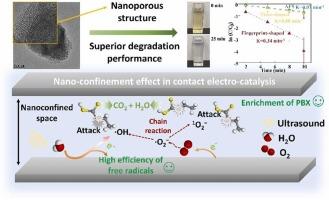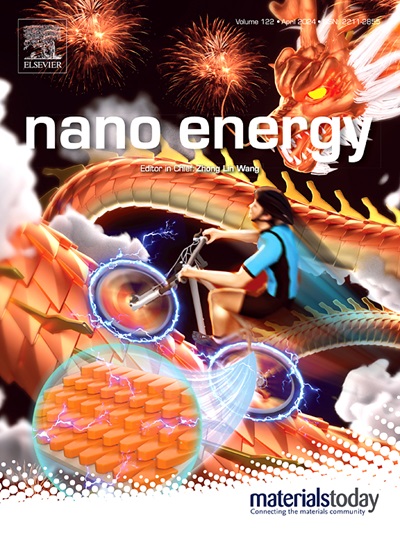Boosting contact electro-catalysis efficiency via nano-confinement effect in organic wastewater degradation
IF 16.8
1区 材料科学
Q1 CHEMISTRY, PHYSICAL
引用次数: 0
Abstract
Contact-electro-catalysis (CEC) technology has emerged as a highly efficient and cost-effective technology for water contaminant degradation, which relies on the advanced oxidation processes (AOPs) induced by dielectric catalytic particles. However, the necessity of using hydrophobic particulate catalysts causes agglomeration issues, hindering the CEC efficiency due to insufficient utilization of reactive oxygen species (ROS). Herein, we synthesized a nanopore-rich and highly dispersed fluorinated catalyst, which showcased a remarkable increase in the kinetic rate of CEC-induced organic pollutants degradation by nearly 1000%. This exceptional performance is primarily attributed to the improved water dispersibility of fluorinated catalysts, which more efficiently activate the catalytic sites without agglomeration hindrance. Meantime, the nanopores facilitate the rapid accumulation and nano-confinement of pollutants within its porous structure, which significantly reduces the mass transfer distance for ROS. This new catalyst design concept, along with the revealed underlying mechanisms, provides key theoretical guidance for the industrial application of CEC technology in the future.

利用纳米约束效应提高接触电催化降解有机废水的效率
接触电催化(CEC)技术是一种高效、经济的水污染物降解技术,它依赖于电介质催化颗粒诱导的高级氧化过程(AOPs)。然而,由于必须使用疏水颗粒催化剂,导致团聚问题,由于活性氧(ROS)的利用不足,阻碍了CEC的效率。在此,我们合成了一种富含纳米孔且高度分散的氟化催化剂,该催化剂对cec诱导的有机污染物的降解动力学速率显著提高了近1000%。这种特殊的性能主要归因于氟化催化剂的水分散性的改善,它更有效地激活催化位点而没有团聚障碍。同时,纳米孔有利于污染物在其多孔结构内的快速积累和纳米限制,这大大缩短了ROS的传质距离。这一新的催化剂设计理念,以及揭示的潜在机理,为CEC技术未来的工业应用提供了关键的理论指导。
本文章由计算机程序翻译,如有差异,请以英文原文为准。
求助全文
约1分钟内获得全文
求助全文
来源期刊

Nano Energy
CHEMISTRY, PHYSICAL-NANOSCIENCE & NANOTECHNOLOGY
CiteScore
30.30
自引率
7.40%
发文量
1207
审稿时长
23 days
期刊介绍:
Nano Energy is a multidisciplinary, rapid-publication forum of original peer-reviewed contributions on the science and engineering of nanomaterials and nanodevices used in all forms of energy harvesting, conversion, storage, utilization and policy. Through its mixture of articles, reviews, communications, research news, and information on key developments, Nano Energy provides a comprehensive coverage of this exciting and dynamic field which joins nanoscience and nanotechnology with energy science. The journal is relevant to all those who are interested in nanomaterials solutions to the energy problem.
Nano Energy publishes original experimental and theoretical research on all aspects of energy-related research which utilizes nanomaterials and nanotechnology. Manuscripts of four types are considered: review articles which inform readers of the latest research and advances in energy science; rapid communications which feature exciting research breakthroughs in the field; full-length articles which report comprehensive research developments; and news and opinions which comment on topical issues or express views on the developments in related fields.
 求助内容:
求助内容: 应助结果提醒方式:
应助结果提醒方式:


